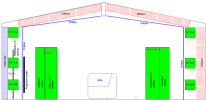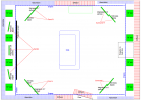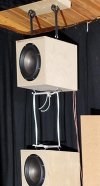I came to ask about the installation details, but I can see them here. Very nice. I'm surprised it works so well because this relationship of subs to wall is meant to be the worst option, the best being flush in/with the wall, and next best being subs firing towards wall. But your results show that these minor details are dwarfed by the improvements from having the plane wave.
You connected 2 subs per channel to the front but 3 per channel at the rear. Perhaps some/all of the SPL difference is load (ohms/wiring) related? Or maybe not, I'm not 100% on the effects of wiring vs ohms vs power vs SPL.
I can share a little details about the installation. Attached here are two simple drawings of the room layout that should explain most of it. The shape of my room with its cathedral ceiling is not optimal for DBA. The subwoofers should also be placed flush to the front and rear walls, which they are not. There are also five very large speakers in the room that will disrupt the plane wave. Even so, it works very well with some tuning.
I also mentioned that the subwoofers are hung (like a pendulum) from the ceiling using rubber rope and rubber straps. This is done to avoid vibration transfer from the subwoofers to the structure of the room itself. The longer the pendulum, the lower will the resonant frequency of the pendulum itself be as well. Assuming gravity is 1G, a 2 meter pendulum will have a resonance frequency of just 0.35 Hz, way lower than the frequency range of the subwoofers.
I have different number of amp channels and wiring schemes for the front and rear arrays, and the gain of the amps used is also different. That really got me confused! I've always thought that something around 9 dB var the correct attenuation of the rear array in my room, but measurements of the real SPL coming from each subwoofer (done at 1 cm from the speaker cones) showed that is more like 5 dB.

 audiosciencereview.com
audiosciencereview.com

 audiosciencereview.com
audiosciencereview.com



